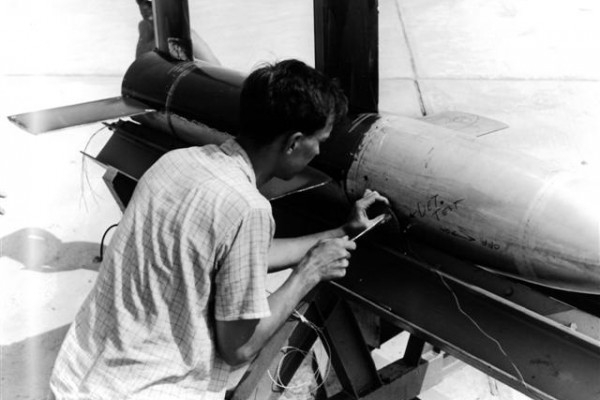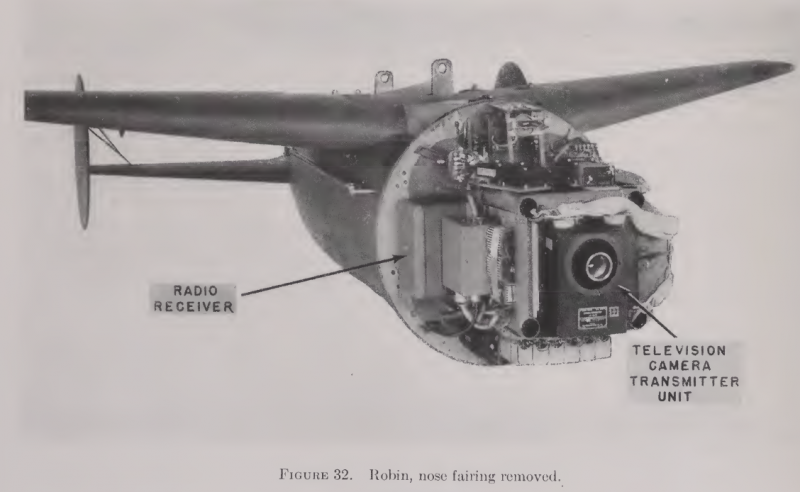BRAKEMINE
By far the most advanced of these projects at the end of the war was Brakemine, a ground-to-air-missile developed jointly by Anti-Aircraft Command and A. C. Cossor Ltd.
This project began early in 1943, when, almost simultaneously, two proposals were written on the subject. The first was by Captain Sedgefield of the Royal Electrical and Mechanical Engineers entitled "Notes on a radio controlled rocket" and the second by Mr. L. H. Bedford, Director of Research at A. C. Cossor Ltd., in conjunction with Mr. Jofeh, describing a similar missile which would be controlled via a radar beam locked onto the target aircraft.
Both of these papers quickly landed on the desk of Major General Sir Frederick Pile, who was then General Officer, Commanding, Anti-Aircraft Command. Pile called a meeting on the 27th of April 1943 to discuss these proposals, at which both Sedgefield and Bedford were present. One outcome of this initial and subsequent meetings was that several sub-committees should be set up to investigate the various subsystems of the missile in more detail, rather than attempt to develop an operational weapon at that stage. However, it is obvious that not all of those present at the meeting agreed with this suggestion. One result was that AA Command decided to "go it alone" and proceed to develop Brakemine under the following guidelines:
1. An AA Command team under Sedgefield, by now a Major, would develop the missile structure, its control, firing and command systems and
2. A Cossor team, working under Bedford, would develop the Brakemine receiver and guidance system. It is worth noting that A. C. Cossor themselves bore the cost of all the services and facilities provided by them.
In February 1944 the first drawings of Brakemine were produced, which showed a missile with 4 wings and 4 control fin surfaces. The thrust was to be provided by eight standard 3 inch solid fuel UP rockets. This design was changed almost immediately to six 3 inch UP rockets as the boost, and to two wings and two control fins. This basic design remained throughout Brakemine's development, and an example of this missile (see Figure 2) is on display at the Royal Electrical and Mechanical Engineer's museum at Arborfield, near Reading in England.
Work on Brakemine was halted for approximately 1 month during June and July 1944, when the V-1 attack on England began, but despite this the first dummy test round was ready for firing in the late summer of 1944. It was launched into the North Sea from Walton-on-Naze in Essex at the end of September 1944.
Brakemine was a radar beam rider missile. As the designer of its guidance system, L. H. Bedford later wrote:
"What we set out to do was to make a missile ride the axis of a conventional conically scanned radar beam, taking it as we found it without any special coding or command link features. What the missile had to do, therefore, was to interpret the radar signals as to reckon its displacement from the beam axis and then to make the manoeuvres necessary to null this."
The radio receiver was contained in the space inside the circle of the six boost rockets, and the gyroscopes and servo-motors were mounted at the front of the missile. The system of control and change of direction was by "twist and steer", essentially the same as that used in aircraft. The hydraulically operated control surfaces were mounted at the rear of the missile.
Brakemine Parameters
Length 2.01 meters
Body diameter 0.27 meters
Wing span 0.84 meters
Range (approx.) 8 kilometers
Weight 145 kilograms
Maximum speed Supersonic
As is the case with all such projects, early failures occurred. The first two dummy rounds with the control fins locked in the neutral position did not fly far, and ended up in the sea just off Walton-on-Naze. Round 3 disintegrated just before the end of its flight, and this problem was eventually traced back to differential heating between the inside and outside surfaces of the whole missile. These and other problems were overcome, and by round 10 confidence was high enough to persuade the technical team to add the guidance system to the Brakemine dummy. This was tested on rounds 11 to 16, when some evidence of control resulted in a decision to increase the size of the control fins and to move the wings forward slightly. Round 17, fired towards the end of 1945, incorporated these changes and was launched into a fixed radar beam. This round also showed evidence of intelligent control of the missile, but by this time the war had ended.
About 20 missiles were fired of the original design, half of them fully equipped with a guidance system but not under control. The improved version of the missile then began trials. The war ended in Europe as these continued. The guidance system had been proved in the meantime and Britain’s first working AA missile was a reality even though still experimental. The post-war run-down of the Army might have killed the project but now the Ministry of Supply took over and continued experiments for two years. The project then moved to Aberporth but no further Brakemines were fired since all effort was concentrated on another experimental missile which subsequently became Thunderbird. REME personnel continued to work with the MOS on these projects well into the 1950s.






